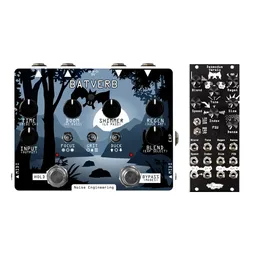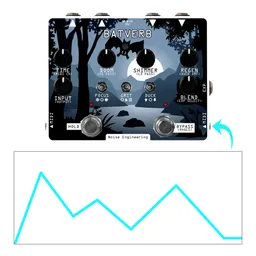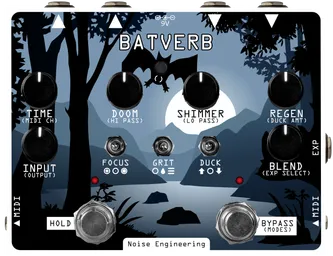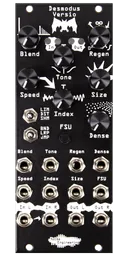After the release of our stereo tail-generating pedal, Batverb, we received a number of questions about its similarities to Desmodus Versio. There’s a lot to chat about on the subject, so if you’re picking between the two, read on for some info on their design, workflow, and differences.

Different hardware, different firmware
Obviously, Batverb and Desmodus Versio are built on different hardware. What may be less obvious, though, is that Batverb shares no code with Desmodus Versio. When we wanted to make a pedal, we started to question all our assumptions about the Desmodus firmware. It had been almost 5 years since we released Desmodus Versio, and we’ve learned a few things since then. Stephen jumped at the opportunity to really rethink the whole premise of our flagship reverb. As a result, Batverb was developed as its own project from the ground up, entirely independently, and entirely rethought from Desmodus.
The decision to create Batverb this way was made due to the differences in application. Batverb was designed first and foremost for processing guitars and tabletop devices, with sounding great on synths (and saxophones, it turns out) being a secondary feature. Desmodus Versio was designed primarily for Eurorack use. While both can be used for either application, the module version was not tested with or optimized for non-Eurorack uses.
Because of this, Batverb takes a lot of inspiration from Desmodus in certain aspects of its workflow, but sounds subtly – or not-so-subtly, in some cases – different from Desmodus.
Perusing parameters
Batverb and Desmodus share some core features: both have Regen parameters that will go beyond 100% feedback for infinite tails, Blend parameters for balancing dry and wet signals, and Time parameters that affect the spacing of the delays in the reverb tails.
A lot of the parameters differ between the two processors, too. Some are similar, yet different in workflow: for example, the Hold switch on Batverb can latch for ease of use when operating by foot, but FSU on Desmodus only creates an infinite atmosphere while held down.
And some are completely different. Batverb features analog input and output gain, to accommodate for the vast variety of levels in guitar and tabletop gear. In Eurorack, modules don’t have as wide of a range of output levels, and it’s easy to patch up an attenuator or VCA to change the level of a signal when necessary, so level controls would have been an unnecessary use of valuable panel space. Batverb features a tuneable Duck control for this reason: guitar outputs vary greatly, so making sure that ducking works as it should requires some parameterized fine tuning. We also added a gated reverb mode to Batverb that plays nicely with guitar performance.
Desmodus Versio has three reverb modes: a clean mode, a shimmering mode, and a distorted mode. Batverb has its own unique form of distortion on the Grit switch, and incorporates Shimmer as its own parameter, as well as adding Doom for chaotic undertones, too.
Desmodus Versio also features a host of modulation options: its built in LFO with Speed and Index controls allows for slow, evolving textures that are great for minimal patches. Batverb was designed to perform with no delay-line modulation, which sounds cleaner when played through things like guitar amps.
Speaking of modulation, Desmodus Versio offers different ways that the delay lines respond to timing parameter changes, from smooth to chaotic. Batverb smooths all timing changes to be as clean as possible, and quantizes them to octaves – a trick inspired by the Imitor Versio.
Pick your workflow
The biggest difference between the two units is their workflows. While they both have their own sounds, both are fantastic atmospheric processors, and if you want to experiment with infinite soundscapes and walls of reverb you’ll be happy with either one.
Batverb was designed to work as a pedal: it has two performable footswitches, and a routable expression (or CV) input for on-the-fly parameter adjustments during a performance. It also features full MIDI control, so you can automate parameters from another controller or your DAW, and save and load presets with MIDI Program Change messages on the fly, great for in the studio or during a performance. Adjustable input and output gain mean you can tweak your gainstaging to keep things clean (or gritty).
Desmodus Versio was designed as a truly modular processor. While Batverb has a single expression input, all of the parameters on Desmodus can be modulated with CV, integrating tightly with any modules you want to patch with it. Desmodus can also be a noise generator all on its own with the help of the FSU button and gate input.
If you have an extensive Eurorack setup, Desmodus Versio may suit your needs better. If you’re a guitarist, mainly use tabletop synthesizers and effects, or just like some out-of-the rack processing, Batverb may be the better choice.
And if you want to use either unit for both desktop processing and modular patches, Nive Grad is the perfect level shifter for making modular work with line- and pedal-level signals.
Why not both?
Of course, if you’re a huge fan of reverbs like we are, one atmosphere generator may not be enough. In this patch, we used both Desmodus Versio and Batverb as processors, creating absolutely stunning soundscapes from anything we threw at it.








